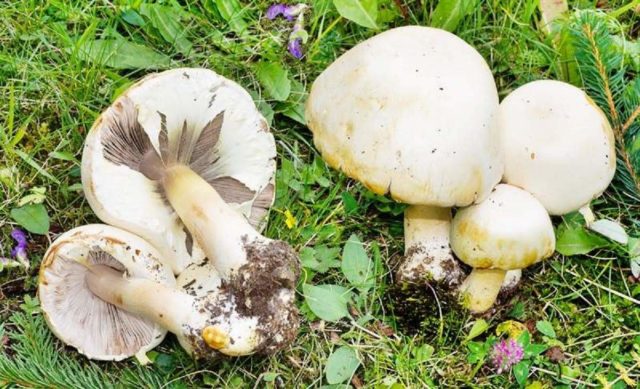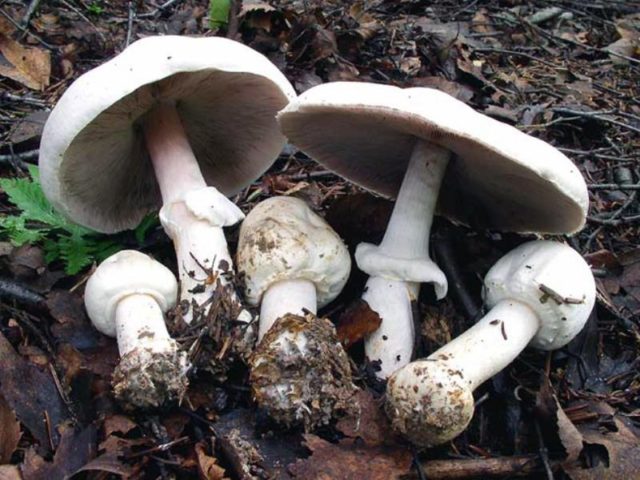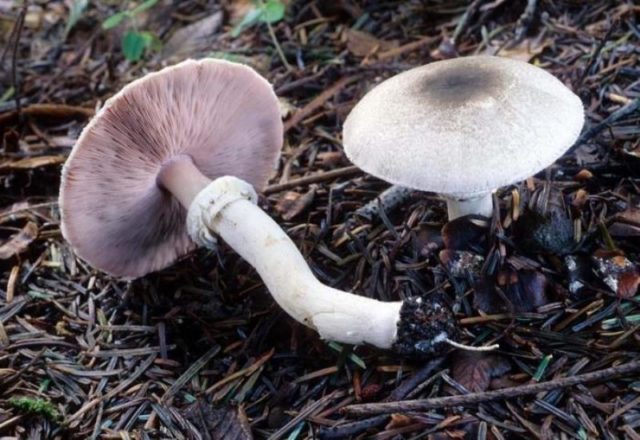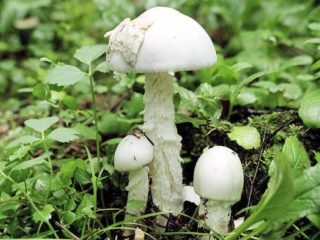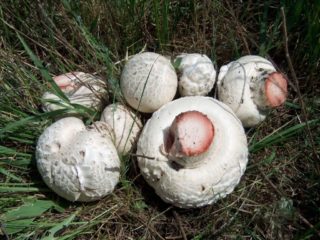Content
Champignon yellow-skinned, or red, is a poisonous, medicinal mushroom. When consumed in large quantities, it causes poisoning, up to and including death. Grows everywhere in mixed forests, within the city, in gardens and vegetable gardens. To recognize the species and not harm the body, you need to familiarize yourself with external data, view photos and videos.
What does yellow-skinned champignon look like?
Acquaintance with yellow-skinned champignon should begin with a description and a photo. The fruit body has a hemispherical cap, ranging in size from 5 to 15 cm. As it matures, it takes on a bell-shaped shape with inwardly curled edges. The surface is matte, white-gray with dark small scales. When pressed, a yellow spot and an unpleasant pharmacy odor appear.
The spore layer is formed by thin, adherent to the stalk, light pink plates, which become dark brown at full maturity. The plates are covered with a dense film, as it grows, it breaks through and goes down to the leg. Reproduction occurs by elongated spores, which are located in dark chocolate powder.
Cylindrical, dense leg up to 2 cm high, 15 cm thick, thickens downwards, painted to match the cap. The flesh of the yellow-skinned champignon is tough, brownish in color, turns yellow or rusty on the cut, and tastes hot and spicy. Many people determine the authenticity of the species on the tongue, but experienced mushroom pickers do not recommend this, since the reaction to toxins can be unpredictable.
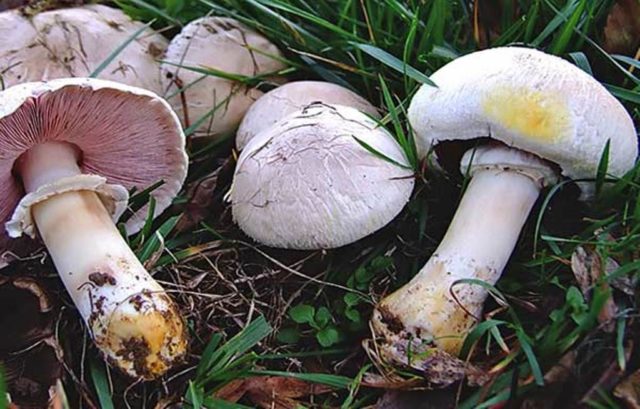
When pressed, a yellow spot remains
Where does the red champignon grow?
The yellow-skinned champignon is ubiquitous. Prefers open sunny places, low grass. It grows among coniferous and deciduous trees, in squares and parks, often found in personal plots. The yellow-skinned champignon grows in small families, often forms a witch's circle, bears fruit from July to October. The greatest growth occurs in sunny weather after rain.
Champignon yellow-skinned edible or not
Red champignon is a poisonous species, therefore, during mushroom hunting, you need to be extremely careful and know the distinctive features. To do this, you can view a photo of a ginger champignon:
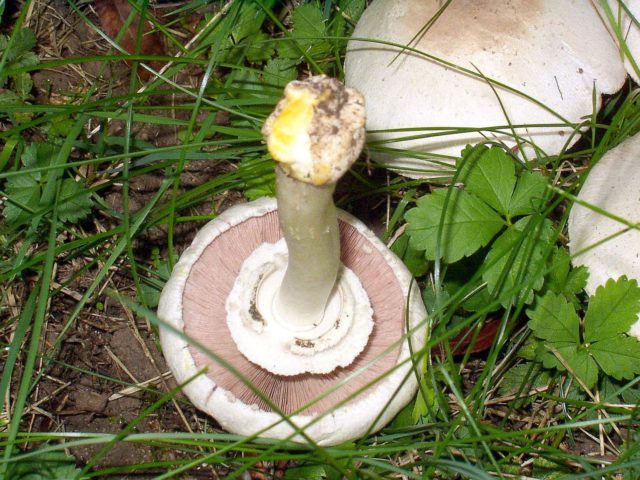
The mushroom is poisonous, it is not used for food
In order not to harm yourself and your loved ones, you need to be able to recognize edible species from poisonous ones. Similar cousins of the yellow-skinned champignon:
- Champignon Esseta - has a spherical cap, which straightens as it grows, leaving a small mound in the center. The surface is matt, painted white. The lower layer is formed by frequent pink plates, which are covered with a dense film at a young age.The fleshy, cylindrical leg has a light pink tint. Champignon Esseta grows in coniferous forests from May to October. The pulp is tasty and aromatic; only young specimens collected in an ecologically clean place are used for food.
Delicious pulp and mushroom aroma
- Curve champignon - at a young age it has a stupidly bell-shaped hat, then it straightens and becomes truncated with curved edges. The surface is silky and creamy. When pressed, a yellow spot remains on it. The leg is dense, fleshy. Curve champignon grows in coniferous forests during the whole warm period. Due to its delicious, aromatic pulp, the species is widely used in cooking. It makes delicious salty, fried and pickled dishes.
Eaten fried and canned
- Mushroom flat-lipped - has an ovoid, then a flat gray-whitish cap with numerous dark scales. The leg is long, fibrous, surrounded by a ring. Fruiting in autumn in mixed forests, often forms a witch circle. The mushroom mushroom is toxic; it is not used for food, as it causes gastrointestinal upset.
The species is toxic, causes food poisoning
When eating yellow-skinned champignon, severe food poisoning occurs until death. Therefore, you need to know the first symptoms of intoxication and be able to provide first aid.
Symptoms of red mushroom poisoning
Poisonous yellow-skinned champignon, when consumed, causes food poisoning, which appears 2 hours after eating. The first signs of intoxication:
- nausea, vomiting;
- diarrhea;
- epigastric pain;
- cold clammy sweat.
Without assistance, the following happens:
- fever;
- weak pulse and low blood pressure;
- lacrimation and salivation;
- frequent, labored breathing;
- constriction of the pupils;
- convulsions;
- delusions and hallucinations;
- agony.
First aid for poisoning
When the first signs appear, a medical team is urgently called. In order to prevent the absorption of toxins into the blood, it is necessary to provide pre-medical manipulations in a timely manner. Before the arrival of doctors, you need:
- Rinse the stomach - give the victim a large amount of water with potassium permanganate.
- If there is no diarrhea, apply a laxative.
- Heat is applied to the stomach and legs.
- Give a plentiful drink: strong tea, still mineral water. Saline solutions are not used due to inflammation of the stomach and intestines.
- Unbutton tight clothing and open vents for fresh air.
- Give absorbents - 10 tablets of activated carbon per 10 kg of body weight.
If, after mushroom poisoning, no medical assistance was provided, then intoxication can be the cause of the development of severe renal and hepatic diseases. Also, inedible mushrooms are dangerous for pregnant women. Toxins cross the uteroplacental barrier and cause premature birth or miscarriage.
Healing properties
Due to its medicinal properties, yellow-skinned champignon is widely used in folk medicine. The fruiting body contains substances that help to get rid of many diseases. The pulp contains antibiotics agaricin and psalliotin, which cope with salmonella, staphylococcus, peptococcus, streptococcus. In addition, it contains substances that inhibit the growth of cancer cells, so yellow-skinned champignon is successfully used for cancer.
Conclusion
Yellow-skinned champignon is a poisonous representative of the mushroom kingdom. When eaten, it causes poisoning, which, without assistance, leads to death.But since the pulp contains useful chemicals, yellow-skinned champignon is widely used in folk medicine. This forest dweller has similar, edible brothers, so you need to know the differences, watch photos and videos.
